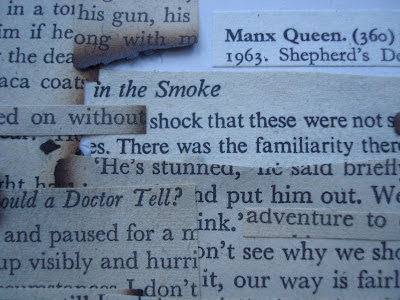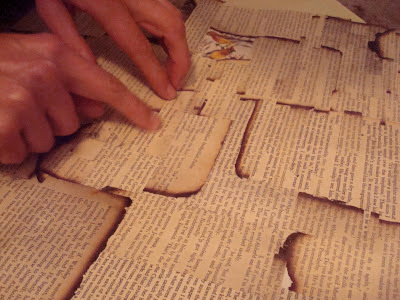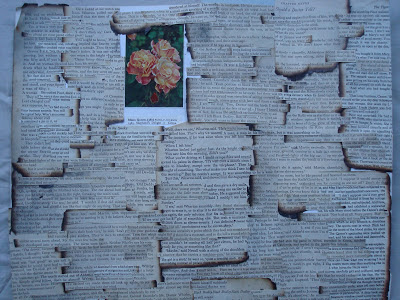The Crime LINKS in the Smoke
 in response to Scott Flanagan's request for an artist book for his edition The Rose Collection, Campbell Walker created a bookwork called The Crime LINKS in the Smoke. It was made from pages of burnt books, sourced from the strewn debris of
detective fiction covering the upper floor of the Dunedin second hand
bookstore Raven Books, where I once worked, and Campbell did for a while
as well.
in response to Scott Flanagan's request for an artist book for his edition The Rose Collection, Campbell Walker created a bookwork called The Crime LINKS in the Smoke. It was made from pages of burnt books, sourced from the strewn debris of
detective fiction covering the upper floor of the Dunedin second hand
bookstore Raven Books, where I once worked, and Campbell did for a while
as well. 

The bookstore's owner, Paddy Rainsford, had been an avid collector of the crime fiction genre, with many rare and signed editions, but his collection had been destroyed in a fire the previous August. A year later, we had gone back to the shop, and Campbell had picked up the pages. The pages were physically cut, pasted and re-ordered into a new sequence in the unique book work given to Scott.
Jacob also penned some thoughtful commentary on the work, under the title of Local Crime : Forensic Iterations in the Modern and Contemporary poetics journal Jacket2, which is readable here :
"New Zealand artist Campbell Walker’s 2012 work The Crime LINKS in the Smoke is an undead work that plays on the print book as both fetishized object and repeatable copy. The Crime comprises cut-up pages from detective novels that were burnt in the fire that destroyed Raven Books, a secondhand bookshop on Princes St in Dunedin, New Zealand. Walker’s book is a memorial both to a particular shop and to the town where it was located. Dunedin, the small city near the southern end of New Zealand where I live, is known for its penguins and sea lions but also for its crumbling Victorian grandeur. Now mainly a university town, Dunedin was once New Zealand’s largest and most prosperous city, and the energetic local cultural scene today springs partly from the spaces opened up by the slow urban decay of a city that never grew. Walker’s work links the fate of Raven Books and Dunedin to the fate of the print codex at a time when bookstores everywhere are closing their doors and e-book sales are increasing exponentially.
By singing Walter Benjamin’s celebration of the codex, Kenneth Goldsmith ironically acknowledged that the book today might just as well mean an e-book or an audiobook, as something made from trees and ink. Walker’s reiterated book seems, by contrast, to stress the material, albeit damaged, paper-based object in the mode of a range of contemporary bookwork art. Indeed, when displayed in the Christchurch Art Gallery (in a city whose past has been even more ravaged––as a result of a terrifying and tragic earthquake two years ago), the work very much takes on these qualities.
Yet The Crime does not follow so many recent bookwork pieces and treat the book as simply a fetishized object for nostalgia. By splicing together crime fiction novels, Walker also emphasizes the repeatability and interchangeability of the genre and its throwaway lines. Walker has also repeated The Crime by performing the work with sound artist and poet Sally Ann McIntyre. (Both McIntyre and Walker once worked in Raven Books.)
If one takes the various documentary digital images and performance into account, The Crime ceases simply to be a forensic record––a document of personal and local history that bears witness to the loss of a bookshop and to Dunedin’s urban decay. Instead, the work becomes about “burning” in the digital sense––the possibility of further copies and versions that unsettle and overlay notions of materiality tied to the paper page."















